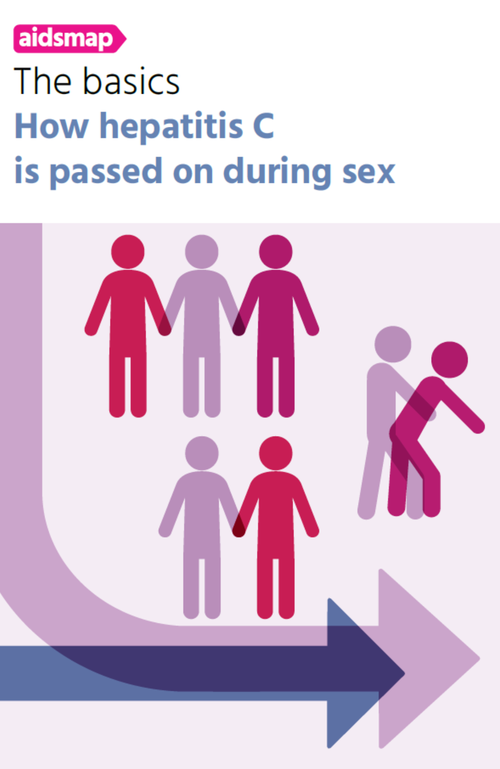
Swiss men living with HIV approach the risk of re-infection with hepatitis C after cure in different ways, based on recent qualitative research by Dr Patrizia Künzler-Heule and colleagues from the Universities of Basel and Zurich. They describe three distinct groups: those who choose to avoid risks and aim not to get re-infected, those who minimise risks and chance re-infection and those who accept risks and the possibility of re-infection and repeated treatment.
The World Health Organization (WHO) has set a target to eliminate hepatitis C as a public health threat by 2030. This has been made possible by a newer form of treatment – direct-acting antivirals. This treatment can cure infection and reduce the risk of liver complications. Men who have sex with men (MSM) living with HIV represent an important risk group for hepatitis C infection, with an estimated prevalence as high as 39%. While many in this group are successfully treated for hepatitis C, they frequently become re-infected later.
The study
As part of the Swiss HCVree trial, MSM living with HIV and hepatitis C received direct-acting antivirals for hepatitis C. Men reporting sexual risk behaviour also received behavioural counselling aimed at teaching risk reduction strategies. Of those who had received counselling, a subset of 17 participants were interviewed six to 12 months later, regarding their views on the cure, the behavioural intervention, their risk behaviours and any subsequent changes. The results were published in BMC Infectious Diseases.
The men had a median age of 44, the majority were White (94%) and nearly half were college educated (47%). The median time since HIV diagnosis was 10.9 years, while the median time since hepatitis C diagnosis was 1.6 years. Most men had had one hepatitis C infection (76%) and had never been treated for it prior to participating in the trial (59%), while six of the men had received prior interferon treatment and one had received direct-acting antivirals previously.
Similarities between groups
Despite expressing scepticism about how useful the counselling would be for them, all 17 participants reflected on potential behavioural changes during the counselling. Most were surprised by their hepatitis C diagnosis and formed three different groups when processing their diagnoses.
Avoiding hepatitis C risk
Some participants felt strongly about not getting re-infected with hepatitis C. They changed their behaviour to avoid reinfection, often prior to starting treatment or the behavioural intervention. These men expressed shock about their diagnoses, as they tended to associate hepatitis C with intravenous drug users.
“Where in the past you went wild with drugs, in the scene, drugs and party culture. Where night after night you took ecstasy and went wild dancing. And then of course you had a relatively large number of sex partners, which changed up a lot. That was before [my current] relationship.”
The median time since diagnosis for most of these men was long (5.8 years), with many diagnosed before direct-acting antiviral therapy was an option. Hepatitis C was viewed as a “serious and socially limiting problem” leading to liver damage, with danger of transmission to partners. This meant that these men viewed the cure as “an immense chance” and the behavioural intervention as a way of reinforcing and strengthening their motivation to avoid risk of re-infection altogether.
“The light went on for me. In the sense of just thinking before you do something. Before, I didn’t have any knowledge of where you can get hepatitis C. You simply go too far and now you say to yourself: I won’t let it go so far again.”
Some of the changes these men made included using condoms for anal sex, avoiding rough sexual activities (such as fisting) and avoiding sexualised drug use. For this group, re-infection was viewed as personal failure.
Minimising hepatitis C risk
The men in this group aimed to minimise their risk but differed from the first group as they did not believe they were able to avoid risk completely. They had been living with hepatitis C for a shorter time than the first group (median time 1.6 years) and felt it could be controlled, largely thanks to direct-acting antiviral treatment.
“Hepatitis C can cause issues that are to some extent manageable.”
In most cases these men were diagnosed as part of STI screening. Many of them had been engaging in condomless anal sex with multiple partners for a long period before receiving their diagnoses. While there was concern regarding onward transmission, these men did not report changes in their behaviour before starting the intervention, due to their belief that they must have contracted hepatitis C under exceptional circumstances.
“I did it like this [condomless sex] for a long time before that, and hepatitis C didn’t happen until 2015. I surely didn’t use … [condoms] for ten years. And I had unprotected sex just as often during these ten years.”
These men gained new knowledge regarding transmission during the behavioural counselling, like the risks of hepatitis C transmission from using anal douching equipment or sharing straws when taking drugs. While they gained a better understanding of their individual risk behaviours, they did not view regular condom use as a realistic option. Instead, they focused on ‘feasible’ changes like using gloves for fisting, not sharing sex toys and decreasing the number of sexual encounters.
“With the life I lead, it [the risk] can only be minimally reduced. And I’d rather have, for example, one encounter less and with that have the risk only once instead of twice. Rather that than… use a rubber and then not have any fun anymore.”
Accepting hepatitis C risk
This group accepted the risks that accompanied their behaviour as they viewed behaviour change as requiring considerable effort, whereas they perceived medical treatment as an easier option. Thus, they accepted – and even expected – multiple rounds of treatment or possibly living with a chronic hepatitis C infection. However, they were concerned about disclosure and the possibility of sexual rejection.
"This group accepted – and even expected – multiple rounds of treatment or possibly living with a chronic hepatitis C infection."
“It’s hard to change much. Because in the moment you don’t want to talk about it. Because that’s when you want to party, have sex, you want to enjoy and you don’t want to say, ‘Hey stop! Hepatitis C!’ Then everything would be over.”
They had lived with hepatitis C for a similar time to the second group (a median of 1.5 years) but went on an intensive search for information to better understand the infection and prevent re-infection. Two had been previously treated with older interferon-based therapy. While some men in this group had opted for some risk-reduction strategies, there was frustration at not knowing exactly how they became infected or re-infected. This occasionally led to abandonment of risk-reduction strategies.
“The first time it was so nice, because I knew exactly where it [hepatitis C] came from, where I got it, from whom... Then it’s easy to say, ‘Ok, I’ll change something.’ But when later I stand there and the liver values are high and I can’t link it to any specific situation, then it’s difficult to change anything.”
One couple spoke of how much easier it was having a partner with both infections:
“What was easy for us was that we had the same thing. He was positive [HIV and HCV] and me, too. That’s why we got together, because we supported each other. Because how do you want to find a life partner that doesn’t have it, that doesn’t understand the problems?”
As these men saw little possibility of changing their risk behaviours, the only reasonable restriction for them that emerged from the behavioural counselling was to have fewer sexual encounters and hope increased testing and cure would lead to less hepatitis C in the community. Direct-acting antiviral treatment was viewed not only as a means to cure infection, or to give ‘the liver a break’, but it also enabled them to engage in the type of sex they wanted to have.
However, in some cases anxiety about re-infection after being cured got in the way of sexual enjoyment. One man likened the anxiety to concerns around HIV transmission in the time before U=U.
Conclusion
The authors conclude that: “The results will facilitate ongoing development of this and similar programs’ behavioural interventions, particularly by identifying intervention components that can be tailored to fit each target group’s attitudes/beliefs… These results also imply important recommendations for clinical practice to enhance the effectiveness of infection prevention components. Participants appreciated individual counselling; and clinicians were well-positioned to first initiate and stimulate risk-related discussions, and then in turn those discussions into teachable moments by addressing and planning concrete behavioural changes.”
Künzler-Heule, Patrizia, et al. Response to a sexual risk reduction intervention provided in combination with hepatitis C treatment by HIV/HCV co-infected men who have sex with men: a reflexive thematic analysis. BMC Infectious Diseases, 21: 319, 2021 (open access).
https://doi.org/10.1186/s12879-021-06003-z

